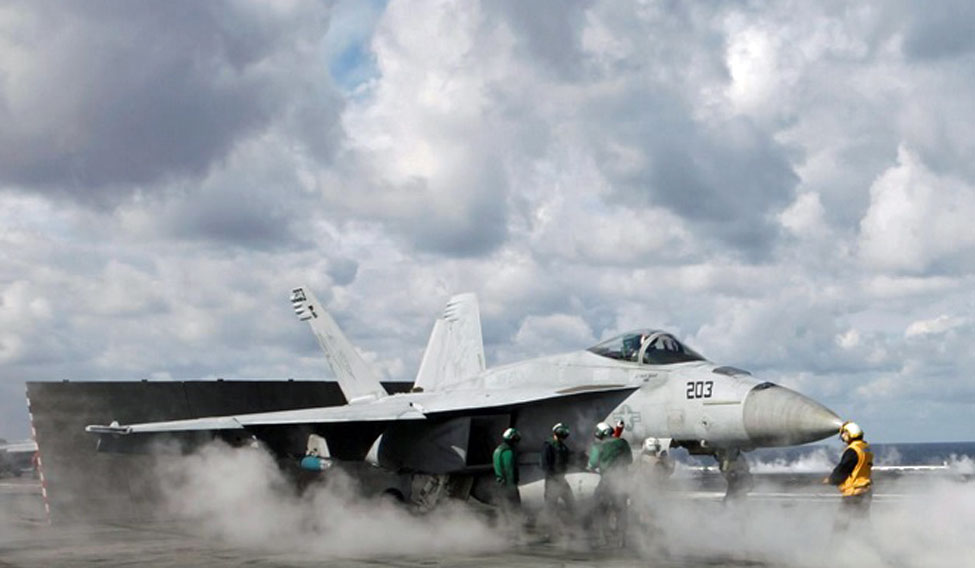As President Donald Trump tours Asia, three US nuclear-powered aircraft carrier battle groups are exercising together in the Pacific. It’s an awesome display of US military power and reach, a reminder of Washington’s unparalleled ability to project global force. At the same time, however, it’s also a sign of how stretched those forces have become.
Getting three carriers to the Pacific has been an intrinsic part of Washington’s strategy to intimidate North Korea. But to do so required pulling forces from a host of other potential conflict areas, including the Gulf.
The ever-increasing demand for military resources in a growing number of places is causing increased concern in the US military. In June, a report by the US. Army War College described America’s military clout as “fraying” and bluntly concluded that the era of U.S. global military primacy that followed the fall of the Berlin wall was over. America’s armed forces have a variety of strategies to tackle that decline but the truth is that coming wars will look very different from the sort of military deployments taken for granted in the recent past.
The change from a decade or so ago could scarcely be starker. In the aftermath of 9/11, America’s conventional military capability was narrowly focused on a handful of locations, primarily Iraq and Afghanistan. The resources plowed into them were stupendous – $5.6 trillion so far, academics at Brown University estimated this month. That would imply a cost per individual US taxpayer of more than $23,000, including future care for veterans.
At their height, those wars dominated US military thinking, planning and workload in a way that is hard to overstate. Working from Pentagon figures, the Brown researchers estimate that some 2.7 million American service personnel passed through those two countries in that time, more than half of them deploying more than once. Officially, however, these conflicts were never seen as endless wars — the hope was always that one last surge of troops would win the day and allow a larger withdrawal.
That didn’t happen, and US military planners now assume there will be a substantial presence in Iraq, Afghanistan and several other countries for years, if not decades, to come. Since the middle of the Obama administration, however, the Pentagon has quietly and comprehensively changed its approach to those wars, aiming for a much more sustainable “advise and assist” model working through local forces.
Speaking at the Association of the US Army meeting in Washington in October, US Army Chief of Staff General Mark Milley made it clear he expected such missions to grow substantially in the years to come. The success of the US-led coalition against Islamic State in Iraq and Syria demonstrates such tactics can work. But there have also been substantial failures and wastage, not least in Afghanistan where local security forces continue to struggle despite absorbing $70 billion of US. funding since 2001.
Much of the burden of US operations in the last 15 years has fallen on a handful of special operations units, whose budgets, personnel numbers and deployments have all risen dramatically. They are now dangerously overstretched, and the US Army is now looking to create more mainstream units to take on unconventional deployments.
With much of the fighting left to local forces, US casualties are substantially lower. But as the death of four US Green Berets in Niger last month demonstrated, putting troops far forward with less backup than they could call on in Iraq and Afghanistan means that when things go wrong, they go bad fast.
Another awkward truth: In the last year US personnel have been more likely to die in accidents than action, the result of a series of incidents including the high profile collisions of destroyers USS Fitzgerald and McCain. That toll suggests that even the parts of the US military that have not been fighting wars are perhaps dangerously overstretched.
That’s been particularly true in Asia, where both the Fitzgerald and McCain were based. Tensions with China and North Korea have kept those units on high alert. In Europe too, heightened tensions with Russia have resulted in a scale of US military activity unseen since the Cold War. US troops, planes, ships and submarines are now on almost continuous exercises to reassure allies and track Russia’s increasingly active forces as Moscow probes NATO air and sea borders.
The Pentagon budget – $825 billion this fiscal year – is rising, and continues to dwarf that of any other nation. But it is also spread much more widely. China and Russia — spending $146 billion and 70 billion respectively – lack America’s global reach, but are more aggressively focused on their own immediate neighborhoods. Both have aggressively plowed resources into techniques and tactics such as cyber warfare and missiles that U.S. tacticians worry might give them the edge in any local war.
Some of that was expected — the Obama administration began its “pivot” to Asia in 2012 because of the perceived growing China threat. Much, however, was not — not least the speed with which North Korea has raced towards being able to strike the U.S. with nuclear-tipped missiles.
Washington’s military capabilities still dwarf anyone else’s. But it now faces a very real danger that its foes may be able to bleed it to death without ever confronting it in battle.
— Reuters





